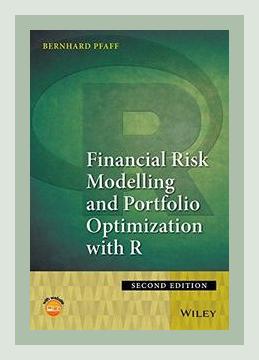Finance, Economics, Trading, InvestingQuantitative Finance and Risk Management
Introduction
“Financial Risk Modelling and Portfolio Optimization with R” by Bernhard Pfaff is an essential resource for finance professionals and academics seeking to deepen their understanding of risk management and portfolio optimization using R. The book combines theoretical foundations with practical applications, making complex financial concepts accessible through the powerful statistical programming language R. Whether you’re a seasoned financial analyst or a beginner in quantitative finance, Pfaff’s work offers valuable insights into the intricacies of financial risk and the tools available to manage it effectively.
Chapter 1: Introduction to Financial Risk Modelling
The book opens with an introduction to the core concepts of financial risk modeling, setting the stage for more advanced topics later. Pfaff emphasizes the importance of understanding the underlying statistical principles that govern financial data. The chapter discusses various types of financial risks, including market risk, credit risk, and operational risk, providing a comprehensive overview that lays the groundwork for the more technical discussions that follow.
Example: Pfaff illustrates the concept of market risk with the example of Value at Risk (VaR), explaining how it measures the potential loss in value of a portfolio over a defined period for a given confidence interval.
Memorable Quote: “Understanding the statistical nature of financial data is the cornerstone of effective risk management, as it allows for the quantification and mitigation of potential losses.”
Chapter 2: Portfolio Theory and Optimization
In this chapter, Pfaff delves into the fundamentals of portfolio theory, discussing the mean-variance optimization framework introduced by Harry Markowitz. The chapter covers the essential concepts of portfolio diversification, risk-return trade-offs, and the efficient frontier, all of which are crucial for constructing optimized portfolios.
Example: Pfaff walks the reader through a step-by-step example of constructing an efficient portfolio using R, demonstrating how to balance risk and return by selecting the optimal combination of assets.
Memorable Quote: “The art of portfolio optimization lies in balancing the dual objectives of maximizing returns while minimizing risks—a delicate balance that requires both statistical acumen and financial insight.”
Chapter 3: Risk Modelling with R
Pfaff transitions from theory to practice in this chapter, focusing on the implementation of risk models using R. He introduces several risk modeling techniques, including GARCH (Generalized Autoregressive Conditional Heteroskedasticity) models for volatility forecasting and copula models for dependency structures between financial assets.
Example: An in-depth walkthrough of a GARCH model implementation in R showcases how to model and forecast the volatility of financial returns, a critical aspect of risk management.
Memorable Quote: “R is not just a tool for data analysis; it is a gateway to understanding and modeling the intricate dynamics of financial markets.”
Chapter 4: Advanced Portfolio Optimization Techniques
Building on the basics of portfolio optimization, this chapter explores advanced techniques such as Black-Litterman models, factor models, and robust optimization. Pfaff provides detailed explanations of each technique, supported by R code examples, enabling readers to apply these methods to their own portfolios.
Example: The chapter includes a practical example of implementing a Black-Litterman model, which combines market equilibrium with subjective views to create more stable and realistic portfolio allocations.
Memorable Quote: “Advanced portfolio optimization is not just about maximizing returns; it’s about creating portfolios that can withstand the uncertainties and volatilities of real-world markets.”
Chapter 5: Risk Measures and Backtesting
Pfaff dedicates this chapter to discussing various risk measures, including VaR, Expected Shortfall, and stress testing. He emphasizes the importance of backtesting risk models to ensure their reliability and effectiveness in different market conditions.
Example: The chapter features a comprehensive backtesting example using R, where Pfaff demonstrates how to validate the accuracy of a VaR model by comparing its predictions against actual market outcomes.
Memorable Quote: “A risk model is only as good as its backtesting results—rigorous testing is the key to ensuring that your models are robust and reliable.”
Chapter 6: Practical Applications and Case Studies
The final chapter of the book brings together all the concepts discussed earlier, applying them to real-world financial scenarios. Pfaff presents several case studies that illustrate how financial institutions use risk modeling and portfolio optimization techniques in practice.
Example: One case study focuses on the optimization of a pension fund’s portfolio, demonstrating how the fund managers use a combination of VaR and mean-variance optimization to achieve a balance between growth and risk.
Memorable Quote: “The true value of financial risk modeling lies in its application to real-world problems—only then can its full potential be realized.”
Conclusion
“Financial Risk Modelling and Portfolio Optimization with R” by Bernhard Pfaff is more than just a textbook; it is a comprehensive guide that bridges the gap between theory and practice in financial risk management. Pfaff’s ability to demystify complex concepts and provide hands-on examples makes this book a valuable resource for anyone looking to enhance their financial modeling skills using R. As financial markets continue to evolve, the techniques and insights offered in this book remain as relevant as ever, providing readers with the tools they need to navigate the uncertainties of the financial world.
SEO Considerations:
- Keywords: “Financial Risk Modelling,” “Portfolio Optimization,” “R programming,” “risk management,” “Bernhard Pfaff.”
- Subheadings: Each section should include keyword-rich phrases such as “Introduction to Financial Risk Modelling,” “Portfolio Theory and Optimization,” “Risk Modelling with R,” “Advanced Portfolio Optimization Techniques,” “Risk Measures and Backtesting,” and “Practical Applications and Case Studies.”
- The title “Financial Risk Modelling and Portfolio Optimization with R” and the author’s name Bernhard Pfaff should be used multiple times throughout the summary to enhance SEO.
Final Thoughts
Pfaff’s book has received widespread acclaim for its clarity, depth, and practical relevance. It is a must-read for financial professionals, academics, and anyone interested in mastering the art of financial risk management and portfolio optimization using R. In the ever-changing landscape of financial markets, the insights provided in this book offer a strong foundation for making informed and strategic decisions.
Finance, Economics, Trading, InvestingQuantitative Finance and Risk Management
